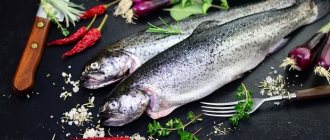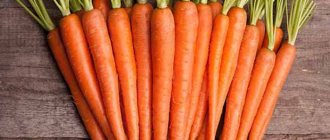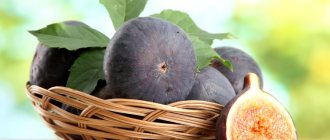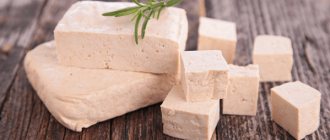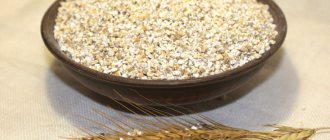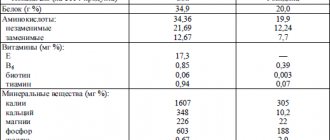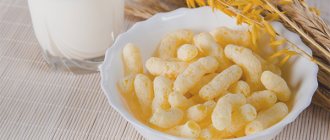Belonging to the salmon family, trout is considered one of the most exquisite varieties of fish. Known for its excellent taste, as well as beneficial properties, it, unfortunately, rarely appears on the tables of ordinary citizens due to its very high price. Nowadays it is mainly bought only on holidays as a delicacy, but despite this, in reality, trout is excellent for the everyday diet. This article will talk about the benefits and harms of trout for the human body.
Vitamins in fish
Trout is rich in vitamins. A 100-gram serving of this fish contains:
- retinol equivalent, A - 16.224 mcg;
- thiamine, B1 - 0.345 mg;
- riboflavin, B2 - 0.327 mg;
- choline, B4 - 66.012 mg;
- pantothenic acid, B5 - 1.936 mg;
- pyridoxine, B6 - 0.197 mg;
- folic acid, B9 - 12.112 mcg;
- cobalamin, B12 - 7.684 mcg;
- ascorbic acid, C - 0.499 mg;
- tocopherol equivalent, E - 0.191 mg;
- phylloquinone, K - 0.092 μg;
- niacin equivalent, PP - 4.447 mg.
In addition, the product contains vitamin D (calciferol). The concentration of this compound is 3.967 mcg per 100 g.
Delicious trout recipes
As a rule, all trout dishes are characterized by excellent taste, regardless of the cooking method. Trout meat can be fried, boiled, baked, or boiled with vegetables. Therefore, it makes sense to offer several delicious recipes from this healthy fish.
Trout soup cooked on a campfire
To prepare a tasty and healthy dish you will need:
- Trout meat – about 600 grams
- Half a kilo of potatoes.
- Three medium sized onions.
- A couple of tomatoes.
- Three small carrots.
- Salt, spices and herbs.
How to cook:
- The head and tail are cut off from the fish carcass, after which they are placed in water and the broth is boiled.
- After the water boils, onions and offal are added here, after which the dish is again brought to a boil.
- Onions and offal are discarded from the broth.
- Instead, chopped potatoes, carrots, salt and spices are added to the broth.
- Greens and tomatoes are also added here. The soup is ready.
- The best option for preparing such fish soup is coals.
Lightly salted trout for sandwiches
To do this you should prepare:
- Half a kilo of trout meat.
- Half a lemon.
- Black pepper and salt.
Cooking method:
- The fish is cleaned, cut and washed, after which all bones are removed from the meat, and the fish is cut into small pieces.
- Lemon is cut into thin slices.
- The fish is salted and peppered.
- The trout meat is placed in a container, covered with a lid and placed in the refrigerator for one night.
The next morning, the fish can already be used to prepare cold appetizers.
Trout baked on coals
To prepare this real delicacy, you will need the following products:
- 0.5 kg trout meat (fillet).
- 4 tablespoons of vegetable oil.
- One lemon or lime.
- 3 tablespoons soy sauce.
- 1 teaspoon sugar.
- One bunch of dill.
- Hot red pepper (a little bit).
Proper preparation method:
- The fish is washed, dried and cut into pieces.
- The marinade is prepared by mixing lemon juice, soy sauce, vegetable oil, sugar and pepper. Finely chopped dill is also added here.
- The fish is soaked in the marinade for half an hour.
- After this, the fish is laid out on the grill and cooked until golden brown.
Trout baked whole in the oven
To prepare a tasty and healthy dish, you need to prepare the following products:
- One trout carcass.
- A couple of onions.
- 20 grams of fennel.
- Four potatoes.
- Three tomatoes.
- One lemon.
- A couple of cloves of garlic.
- Salt and spices.
Technological stages of preparation:
- The fish is cleaned and the entrails are removed.
- Sprinkle with lemon juice and rub with a mixture of spices.
- Onions are fried with the addition of fennel, after which the fish is stuffed with this mixture.
- The fish is watered with vegetable oil.
- First, tomatoes are laid out on a baking sheet, and stuffed trout is placed on top. The dish is baked for 40 minutes at a temperature of 180-200 degrees. The fish will be ready if a golden crust has formed.
Trout steaks
You will need the following products:
- 6 pieces of fish steaks.
- Three carrots.
- Four onions.
- Two lemons.
- About 3 tablespoons of vegetable oil.
- Herbs, spices and salt to taste.
How to prepare the dish:
- Fish steaks are poured with lemon juice, salted, peppered and fried in a frying pan.
- In another frying pan, chopped vegetables are cooked.
- The cooked steaks are laid out on a plate, and fried vegetables next to them.
Trout cooked in champagne
To prepare this exclusive dish, you need to prepare the following ingredients:
- Two rainbow trout carcasses.
- One glass of champagne or sparkling wine.
- About 70 grams of butter.
- About 80 ml of milk.
- Three tablespoons of flour.
- Butter – 60 grams.
- Two onions.
- One yolk.
- About 100 ml sour cream.
- Salt, spices to taste.
How to prepare the dish:
- Fish carcasses are cleaned, gutted and washed thoroughly under running water.
- The trout is placed in milk with salt and spices.
- The trout meat is taken out and dredged in flour, after which it is fried until golden brown.
- Prepare the sauce: add chopped onion to the melted butter, after which it is simmered over low heat. Champagne, sour cream and egg yolk are also added here.
- The fish is laid out on a large dish, after which it is poured with sauce.
Trout is a delicious fish, which contains many useful substances that have a positive effect on human life.
Calorie content of trout
100 g of raw trout contains 149.517 kcal. The same amount of boiled fish - 138.618 kcal, baked - 156.804 kcal, salted - 150.001 kcal, fried - 238.524 kcal, stewed - 168.903 kcal, smoked - 172.994 kcal. The energy value of 100 g of trout fish soup is 27.844 kcal. A 100-gram serving of cutlets from this fish contains 225.412 kcal.
Lightly salted trout
Today you can buy it in any supermarket, or you can prepare it yourself. Lightly salted red fish is an excellent ingredient for small canapés, sandwiches or appetizers. The peculiarity of this fish is that trout lives only in clean waters, therefore, when buying trout, you can be sure of the purity of this product. Lightly salted trout is as healthy as steamed or boiled fish. 100 grams of this product contains only 88 kcal and little fat, so it can safely be classified as dietary. Trout is called red fish not only because of its color, but also due to its importance for the human body.
Selection of fish
Trout is a fairly expensive fish, and therefore it is very important when going to the store to choose the highest quality and freshest product in order to get a large amount of useful substances. When purchasing, be sure to pay attention to:
- The color and elasticity of the skin, as well as the overall presentation. Slippery and elastic skin indicates the freshness of the fish. However, if the fish looks unnaturally bright, this may indicate that the sellers specially processed it.
- Cloudiness in the eyes - its presence hints that the fish has been lying there for a long time.
- The color of the gills should be pinkish; if they are dark brown, it means the fish is not fresh.
The benefits of lightly salted trout
Trout contains amino acids, phosphorus, iodine, selenium, iron, vitamins of all groups, and polyunsaturated fatty acids. Regular consumption of trout reduces the risk of developing atherosclerosis, improves brain function, and stabilizes the nervous system. Trout meat helps lower cholesterol, normalizes blood pressure, strengthens the heart muscle and improves memory. In addition, being hypoallergenic, it is approved for use by allergy sufferers and people suffering from diabetes and psoriasis. Trout is also useful for cosmetic purposes - it is added to creams and masks, but such cosmetics are expensive.
River trout

Now let's move on to finding out the benefits and harms of river trout. It lives in streams and rivers located in mountainous areas, since this is where the waters are the cleanest. It is this variety that is considered the most valuable, since the meat of this fish is clean and very nutritious, and also has a delicate flavor.
It is small in size - the usual size of wild individuals is about 35 cm, and its weight is no more than half a kilogram. The color of its meat is usually pinkish.
Now we will directly consider the benefits and harms of trout of this species. First of all, fish is considered a valuable source of animal protein, which is very well absorbed by the body. The huge amount of amino acids contained in it helps improve protein metabolism, and also affects the functioning of the cardiovascular system and helps cope with anemia. Quite often, river trout is recommended for consumption by people who suffer from severe and long-term illnesses to replenish their strength.
The role of unsaturated fatty acids, which are found in large quantities in trout, cannot be underestimated. They prevent the development of atherosclerosis, and also help cope with ischemia, heart attacks and strokes, and often even prevent them.
Harm and contraindications
Due to the presence of salt in lightly salted trout, it is contraindicated for hypertensive patients. This product should also be taken with caution by people suffering from diseases of the intestines, liver and stomach.
Trout is a member of the salmon family. This fish is notable for the fact that it lives exclusively in clean water bodies - it is adapted to both sea and fresh water. That is why trout meat has distinctive taste and healthy qualities, and does not have the specific smell and taste inherent in other types of fish.
The calorie content of trout is quite low - no more than 90 kcal/100 g. If you take smoked fillet, the calorie content is 140 kcal/100 g, lightly salted trout contains 190 kcal/100 g. The most high-calorie of the above is fried fish meat - it contains about 200 kcal/100 g.
Salted trout: is it healthy?
The benefits and harms of salted trout also cannot be underestimated. With the help of this product you can significantly influence the functioning of the most important systems in the human body. Omega-3 fatty acids help maintain normal cholesterol levels in the blood and also affect the condition of the circulatory and nervous systems. Surprisingly, in salted trout you can find 8 amino acids, which doctors consider necessary for a person to lead a normal life. A huge amount of protein is also necessary to maintain health, and together with fats, vitamins and other beneficial substances, this product is often indispensable on the tables of athletes.
Among the harmful qualities, it is worth mentioning that such fish should not be consumed by people with diseases of the liver and gastrointestinal tract, since fats and salt can harm them.
What are the benefits of trout?
First of all, the beneficial properties of trout are found in the rich content of substances necessary for the body. Vitamins A, D, C, PP, K, B vitamins, micro- and macroelements (potassium, calcium, magnesium, phosphorus, sodium, iron, selenium), polyunsaturated fatty acids Omega-3 and Omega-6 - a fairly rich composition for dietary product. The combination of all these valuable components has an extremely positive effect on human health, namely:
- Regulates blood sugar, removes cholesterol, cleanses the walls of blood vessels and thereby prevents the development of hypertension and problems with the cardiovascular system;
- Removes toxins from the body - improves the general condition of the skin, hair and nails. Increases the body's resistance to cancer;
- Reduces the risk of heart attack or its recurrence;
- Increases the body's resistance to stress and fatigue. Improves brain function - in particular memory, attention, mental functions;
- Improves the functioning of the hormonal system of the whole body, affects the quality of reproductive functions;
- Increases immunity;
- Strengthens the bone tissue of the skeleton, increases oxygen metabolism in cells;
- Reduces blood pressure;
- Improves the functioning of the digestive system. Normalizes liver function.
The examples of how trout is useful don’t end there. It is also worth noting that this fish is absolutely hypoallergenic, and the components it contains even contribute to a faster course of allergic reactions. Nutritionists and doctors recommend including trout in the diet of diabetics and people suffering from skin diseases.
Energy value
Almost all the health benefits and harms of trout depend on its nutritional value. The large amount of omega-3 fatty acids, vitamins, microelements and amino acids it contains gives the fish an incredibly refined taste, and also helps provide the human body with all the beneficial substances it needs.
In addition, this fish has a relatively low calorie content - only 88 kcal per 100 grams, so even those who want to lose weight or adhere to a healthy diet can safely consume it.
Is trout harmful?
As mentioned earlier, trout choose only clean water bodies for their habitat. Therefore, the content of harmful substances, heavy metals and other chemicals in fish meat is unlikely. If you take sea fish, it is advisable not to use its head, since it is in it (in particular in the gills) that all substances harmful to the body accumulate.
Allergy sufferers are not afraid of trout, so again there is no point in talking about the risk of allergies. Due to its low calorie content, it is not recommended to get carried away with eating trout for people experiencing constant physical activity - saturation occurs quite quickly, but little energy is obtained.
Fatty trout varieties should not be consumed by people with gastrointestinal diseases. Due to the possible content of small amounts of mercury, it is not advisable for pregnant and lactating women to consume fish.
The benefits and harms of trout have been described above; now it is worth paying special attention to the properties of its caviar. It is a high-calorie product (240 kcal/100 g) and a storehouse of vitamins (in principle, like any other caviar). And certainly few people don’t like red caviar due to its amazing taste.
In fact, trout caviar contains all the same beneficial substances as fish meat, only in larger quantities. Therefore, this product is optimally suited for people with vitamin deficiencies, during the recovery period after illness, and for various deficiency conditions.
However, you should not overuse caviar, since a large amount of salt is used when preserving it. The daily norm is no more than 5 tablespoons. Therefore, caviar is contraindicated for people with kidney disease, edema, gout and vascular diseases.
Well, those who like sandwiches with red caviar and butter can forget about a slim figure - here the amount of carbohydrates, fats and calories is simply off the charts.
The color of the fish may vary depending on external conditions. So, fish can be light or dark depending on the color of the bottom of the reservoir and the water itself, the food consumed and even the time of year. The number of spots on the sides may vary depending on how filling the fish is.
The size of a fish is affected by its habitat. On average, its length is 30 cm, and its weight is 300 g, less often 500 g. If you grow fish in artificial conditions, you can get larger fish weighing up to two kilograms.
The color of the fish fillet may vary depending on its habitat. Thus, the fillet of freshwater fish has a pinkish color, but the fillet of sea fish is almost red.
The calorie content of fish is relatively small and is about 90 kcal per 100 g.
Features of trout

Before talking about the benefits and harms of trout, you should find out what this fish is. As mentioned earlier, it belongs to the salmon family, which includes a wide variety of species. However, they all have one common feature - they can only live in clean and cold waters, and therefore the quality of trout is usually very high.
In appearance, trout is a fish with an elongated body that is slightly compressed at the sides. Its scales are usually very small and slightly shiny. Its color depends on the color of the water in which the trout lives. Depending on the species, it can have a different size, although its standard weight does not exceed 1 kg and its length is 50 cm. Male trout are usually larger than females and also have a larger head.
The benefits of trout
Trout contains animal protein, which is easily digestible. It also contains a large amount of amino acids, which is what determines the benefits of trout. It is recommended to be used for diseases such as anemia, heart and vascular diseases. Trout is also useful for patients suffering from debilitating diseases.
Trout contains a large number of vitamins and minerals, which make the fish useful and necessary for the diet of every person. It contains B vitamins, as well as vitamins A and D, minerals: phosphorus, selenium, iodine, potassium, etc.
Trout contains many unsaturated fatty acids. These substances are very useful for people who have excess bad cholesterol in the blood. They help remove excess cholesterol and prevent the development of atherosclerosis, which is dangerous, including complications - coronary artery disease, stroke or heart attack.
With regular consumption of trout, you can reduce the risk of cancer, hypertension, and even prevent the development of depression. This fish has a positive effect on the nervous and digestive systems, as well as the liver, improving their functioning.
It is recommended to eat trout if you are in a bad mood, lethargic and severely tired. It also makes the body more resistant to various types of infections. Due to its low calorie content, trout is considered a good dietary product and will be useful not only for those losing weight, but also for all people who follow proper nutrition. It is worth noting that the minimum amount of calories is contained in boiled or steamed fish. Fried or dried trout, of course, will not be a dietary product.
Harmful properties
Trout is not only beneficial, but also harmful to the body, so when introducing it into the diet, all contraindications must be taken into account. First of all, it should be used very carefully during pregnancy and lactation, since fish often contains mercury. And if the proportion of the substance that is in it is tiny for an adult and cannot harm him, then it can affect a child very negatively.
People with ulcers in the gastrointestinal tract and liver disorders should also be very careful about this fish, since the saturated fats it contains increase the level of functioning of the digestive system. It would also be better not to use trout heads when preparing dishes, since it is in them that toxic substances from the reservoirs in which the trout lived accumulate.
Application of trout
Trout can be eaten in all the same ways as other fish. It is perfect for making fish soup, baking, and steaming. You can also bake it in the oven, prepare steak or cutlets from it, fry it and pickle it. It goes well with vegetables and potatoes.
Before frying the fish, it is better to salt it (15-20 minutes before) so that the trout crumbles less. Since it has a specific smell, it is better to season it with lemon juice before processing.
Something about cooking trout
This type of salmon is used in dietary and other nutrition. If possible, use chilled rather than frozen fish. Red fish dishes are available in almost all cuisines of the world. Most often it is baked, but also boiled and fried. This product is very fatty, which makes grilled dishes especially tasty. Lemon, ginger, and herbs go well with trout.
When preparing oriental dishes, red meat is one of the ingredients for making rolls, sushi, as well as various stews and soups. In the Caucasus it is served with pomegranate sauce. In America, it is customary to thoroughly fry this product, but in Japan, trout is not cooked for long and is eaten almost raw. In European countries, before cooking, red fish meat is marinated in spices and then grilled or barbecued.
Salted fish is often consumed with strong alcoholic drinks, and smoked fish is often consumed with wine and beer.
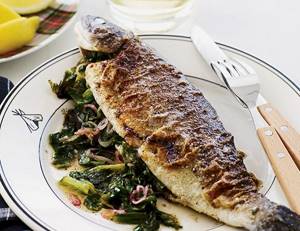
Recipes
Trout balls
Products and ingredients
:
- trout – 1kg
- egg - 1 pc.
- tomato sauce - 1 cup
- salt, allspice, black pepper - to taste
- nutmeg - to taste
- garlic - 5 cloves
- tarragon - to taste
for tomato sauce
:
- tomato paste - 1/2 cup
- onions - 2 pcs.
- flour, sugar, butter - to taste
- fish broth or water
- salt, red pepper - to taste.
Preparation of the Trout Balls recipe
:
Grind the trout in a meat grinder, add egg, pepper, nutmeg, garlic and salt to the meat. Form small balls from the minced meat. We boil them in water. To prepare tomato sauce, you need to fry the onion, pour in tomato paste and pre-fried flour. Dilute this mass with water or fish broth, add salt and sugar. Leave this to simmer for another ten minutes.
Trout with nut sauce
Products and ingredients
:
- trout – 400g
- water - 1/2 cup
- nuts – 50g
- spices, salt - to taste
- sugar - to taste
- greens - to taste.
Preparation of trout recipe with nut sauce
:
Boil the fish in salted water. Place on a plate along with sauce and herbs. Sauce: chop walnuts, add water, sugar, salt and pepper. Start cooking and then pour in the vinegar along with cilantro and mint.
Stuffed Baked Trout (Cantonese Style)
Products and ingredients
:
- trout (large) – 1 piece (1.5kg)
- green onions - 2 pcs.
- carrots - 2 pcs.
- celery (stem) - 1 pc.
- garlic - 1 clove
- ginger (piece) - 1 pc.
- soy sauce - 2 tbsp.
- sugar - 2 tsp.
- vegetable oil or pork fat - 2 tbsp.
- salt, pepper - to taste.
Making the recipe: Stuffed Baked Trout (Cantonese Style)
:
Grind all ingredients, including fish pulp, and add seasonings, vegetable oil and soy sauce. Fry everything in a frying pan. The skin of the fish should be rubbed with salt, pepper and vinegar, and then carefully stuffed with minced meat and tied with thread. Bake in the oven for an hour, adding vegetable oil or lard.
Kutap
Products and ingredients
:
- trout 1 kg
- rice (boiled) - 1 cup
- butter
- raisins - 1/2 cup
- ginger - 1 tsp.
- crackers.
Preparation of the Kutap recipe
:
Process the fish, clean the insides, rub with salt and pepper. As minced meat, take boiled rice with raisins and ginger and mix. Fill the fish with this mixture and bake in the oven.
Smoked trout soup
Products
:
You will need for 4 servings
:
- 20 g butter,
- 7 cloves of garlic,
- 160 g. onions,
- a pinch of ground cumin,
- 200 g sauerkraut,
- 725 ml. white wine,
- 600 ml. vegetable broth,
- 300 g sweet pepper pods of different colors,
- 200 ml. heavy cream,
- 2 tsp. starch,
- salt,
- ground black pepper,
- 750 g smoked trout fillet,
- chervil for decoration.
Preparation
:
Peel the garlic and onions and chop finely. Melt the butter in a thick-walled saucepan and fry the onion, garlic and cumin in it. Add cabbage and wine.
Pour in the broth, cover and cook for 20 minutes.
After 10 minutes, add chopped sweet peppers and cream. Dilute the starch with cold water, pour into the soup, bring to a boil, add salt and pepper. Pour the soup into each bowl, add a piece of smoked trout and garnish with chervil leaves. Trout is a famous delicacy
with a unique taste. This fish lives only in clean waters, so trout lovers can be sure that they are eating a pure product without toxins or harmful substances.
Trout and its caviar are recognized
some of the most delicious delicacies. The meat is tender and has a cream, white or red color. People call fish red not only because of the color of the meat, but also because of the importance and significance of this delicacy.
Fish contains polyunsaturated fatty acids, various amino acids, vitamins of all groups, phosphorus, iron, iodine, and selenium. The benefits and harms of trout depend on these substances
, which is highly valued in medicine, dietetics and cosmetology.
Calorie content of trout per 100 g – 88 Kcal
.
Trout contains many useful substances
, with which it saturates the human body. It improves brain function, reduces the risk of developing atherosclerosis, and eliminates the feeling of fatigue and lethargy.
Fish meat has a positive effect on the nervous system
, calms, lowers cholesterol, helps normalize blood pressure, improves memory, strengthens the heart muscle, protects against depression.
Trout is a hypoallergenic fish
, this product is absolutely safe for allergy sufferers. Doctors advise patients suffering from diabetes and psoriasis to eat fish meat.
Fish also has cosmetic benefits
, its components are included in creams, masks and gels. Products based on trout oil have a powerful rejuvenating effect, which many cosmetologists compare with light injections of botulinum toxins or mesotherapy.
But since trout has little fat, cosmetics based on it are expensive and not popular; they can only be found in the lines of well-known cosmetic companies.
In dietetics, this fish is famous as one of the most beneficial for weight loss.
. But a lot depends on the method of preparation. Substances that enter the body in the form of boiled fish are well absorbed and help in the breakdown of fats.
But, despite all the beneficial qualities of trout, it can be harmful. This product should be used with caution by those who suffer from diseases of the liver, stomach and intestines.
. You should completely avoid trout if you have an individual intolerance to the product, but this is an extremely rare occurrence.
Rainbow trout

One of the most common species that is actively targeted by anglers is the rainbow trout. The benefits and harms of this species, which lives in ponds and lakes, are practically no different from all other varieties. Its standard dimensions are 40-50 cm in length, and its weight is about two kilograms. A special feature is the light shades of the scales, which are almost invisible on the bottom of the lake, which has led to the fact that this fish is often called white trout.
The meat of rainbow trout is light pink, and it is much less fatty than that of sea fish. In addition, it is much less expensive, and therefore can be prepared more often without causing much harm to the wallet.
Now let's talk directly about the benefits and harms of trout fish. Its calorie content is slightly higher - 119 kcal per 100 grams, but it is still a low-calorie product that is suitable for adherents of a healthy diet and people losing weight. It contains a large amount of protein, omega-3, as well as vitamins A, E and D, which are very useful for people’s lives, especially for those who lead an active lifestyle. Also, by regularly eating rainbow trout, you can easily compensate for the lack of potassium, magnesium, phosphorus, zinc, iron and sodium in the body.
Surprisingly, rainbow trout has only one contraindication - an allergic reaction, so if it does not exist, then you can eat this fish for your pleasure without any harm - although this must be done in normal quantities.
Lightly salted trout - benefits and harms
Lightly salted fish is no less healthy than boiled or steamed fish
. It makes delicious snacks, sandwiches and canapés. It contains large amounts of thiamine (vitamin B1) and riboflavin (vitamin B2). Calorie content of the product – 229 Kcal per 100 g.
Lightly salted trout is often recommended for melancholic people
, since the vitamins it contains fight depression and stress. If you eat the product regularly, you can forget about your bad mood forever. Trout removes harmful toxins and prevents intestinal problems.
Due to the high phosphorus content in trout, eating fish improves the functioning of the brain and circulatory system, and has a positive effect on the body.
However, lightly salted trout is contraindicated for hypertensive patients
, since the salt included in its composition increases blood pressure.
sea trout

Now let's talk directly about the benefits and harms of sea trout, as well as its differences from all other varieties. Such fish are considered the most valuable catch for fishermen, since they are very difficult to catch. Its meat is redder in color than all other varieties. Females are usually larger than males, and the fish itself may be larger than its relatives from other habitats. In size it can reach from 50 cm to 1 m, and in weight individuals up to 25 kg have been found, although they rarely actually grow that large.
The meat of this type of trout is fattier and tastier than other varieties, it contains a large amount of vitamins and amino acids, and is also higher in calories. Its frequent use has a positive effect on metabolism, lowers cholesterol, and also helps fight depression and improves memory. It is often recommended for restoring protein and fat metabolism, as well as preventing cancer.
But since sea trout is fattier, it is not recommended for people with diseases of the liver, stomach and duodenum, since it causes damaged organs to work more intensively during digestion.
Harm to the product
Trout brings not only benefits to the body, but also harm. In case of individual intolerance, an allergy may occur. Fish heads should not be eaten as food, since toxic substances accumulate in it.
For women
The composition of vitamins and beneficial micro and macroelements that trout contains is very necessary and important for the female body. Consumption of this delicacy at least 2 times a week contributes to:
- — improvement of emotional state during PMS;
- - reducing fatigue and getting rid of depression;
- - reduction of pain during the menstrual cycle;
- - eliminating depression and other symptoms preceding menopause;
- - improving the condition of skin, hair, teeth.
Red fish can be harmful if you have individual intolerance, problems with the intestines or stomach, or women with liver disease.
For children
Salmon meat should be introduced into a child’s diet no earlier than three years of age, since this fish contains a fairly serious allergen and a lot of fat. Because of this, in some cases it can cause harm to a fragile child’s body. But from the age of three, trout for children can become a real source of energy and vitamins.
Red seafood delicacy should be gradually introduced into a child’s diet from the age of 3 years. To begin with, the portion should be no more than 30 grams per day, then it can be gradually increased to 60-70 grams. In this case, it is best for children to steam, boil or bake the delicacy in the oven without adding spices.
For weight loss
Red seafood has a positive effect not only on healthy people and heart patients, but also on those who want to lose extra pounds. Yes, yes, you heard right. Despite the high fat content in its composition, many nutritionists do not remove this product from the diet of those losing weight and even more recommend including it in food, replacing meat with fish.
- The beneficial elements contained in the seafood delicacy are perfectly absorbed by the body, which means they do not turn into fat, but dissolve, enriching the person with nutrients.
- The calorie content of even salted trout is much lower than that of the same piece of pork, plus the fish is digested very quickly, and its benefits are enormous in stressful situations and depression, to which people on a particular diet are often susceptible.
- A large number of easily digestible vitamins and minerals contained in red fish allow the body to replenish the nutrients lost during weight loss. Consuming one small piece of this delicacy per day allows you to fully replenish the loss of beneficial vitamins and minerals.
Salted trout has a colossal number of beneficial properties. It contains Omega-3 fats, which are very necessary for the human body. Which serve to maintain normal cholesterol levels in the body, and also have a positive effect on the functioning of the brain, vascular and nervous systems.
In addition, salted trout retains all vitamins A, B, and D.
Salted trout also contains a large amount of high-quality protein with essential amino acids.
People with diseases of the gastrointestinal tract and liver should refrain from eating salted trout.
- A contraindication to excessive use of this product is the presence of chronic diseases of the liver, gastrointestinal tract, and stomach ulcers.
- There are many parasites in river fish, and therefore harm may come from insufficient heat treatment of trout.
- Sometimes this fish may contain mercury, which is dangerous for everyone and especially for pregnant women, because it can cause poisoning of the fetus.
- If there is an excess of retinol contained in this product, poisoning of the body may occur. With such intoxication, the following are possible: nausea, liver enlargement, headache and other symptoms.
- It is not recommended to eat this fish if you are allergic.
- If the sea trout is sea trout, then you should not cook it with the head; it may contain harmful substances that have accumulated in the water where the fish lived.
Due to the modern environmental situation, as well as the needs of humanity for fish products, fish are increasingly being grown in artificial reservoirs. However, it is worth understanding that the benefits and harms of trout produced in this way differ significantly from its wild counterparts.
Unfortunately, now in this area various hormones, antibiotics, food additives, preservatives and dyes are actively used, that is, various chemicals that negatively affect the taste and benefits. For example, to give color to meat, the dye canthaxanthin is added to the feed, which negatively affects human vision and also destroys the iris of the eye.
It is impossible not to mention parasites. Since farmed trout live in closed conditions, and in quite cramped ones, often the disease of one individual can lead to the disease of the entire stock. This is why fish are actively fed with antibiotics to prevent financial losses. All this has led to the fact that meat contains such a large number of carcinogens that they only increase the risk of developing cancer, rather than preventing it.
Is trout good for weight loss?
This fish has a unique property. She cannot live in polluted water. With its help, the aquatic environment is checked - if there are toxic substances, the fish dies. The benefits of trout for the body can be listed for a long time.
Omega-3 helps normalize cholesterol levels, eliminates toxins, activates mental activity, and improves the condition of the nervous system. Numerous studies show that regular consumption of healthy meat has a positive effect on the overall well-being of cancer patients.
Frequent inclusion in the diet is the prevention of cancer. It helps normalize blood pressure and improves memory. Delivers a lot of useful vitamins and microelements, reduces the risk of atherosclerosis, increases performance, and fights stress. The phosphorus contained gives a person vigor and energy. B vitamins are indispensable for women's health; they help normalize the condition during the menstrual period.

The benefits of trout caviar are great. It contains protein and fats that are easily digestible. This is a wonderful building material for a small organism. Caviar helps rejuvenate the skin and has the ability to delay the aging process.
Trout is a valuable product for people suffering from anemia. It will help you recover from a debilitating disease. The benefit of rainbow trout is that it helps restore strength in men after heavy stress and hard work. Selenium contained in the composition accelerates the speed of sperm. This is help in the fight against infertility.
The benefit of salted trout is that it contains many useful elements - omega-3, vitamins A, B, protein, essential amino acids, the number of which reaches 8.
The benefits of seafood and its properties allow absolutely everyone to include the product on the menu. Trout helps you get rid of extra pounds. Fatty acids are significantly different from those found in meat. They do not cause harm, are perfectly absorbed and are not stored as fat.
Trout liver is also used to prepare delicious dishes. It is quickly digested. Many nutritionists recommend including healthy seafood and offal in your diet, since they have low calorie content and contain large quantities of important minerals.
Microelements contained in trout have a beneficial effect on various functions of the body: protein and fat metabolism, the formation of red blood cells and other processes.
- Trout is rich in polyunsaturated fatty acids. The human body itself does not reproduce such acids (they are called Omega-3), so it is necessary to consume them in food. As a result of using Omega-3, depression can be avoided. Also, polyunsaturated acids have an anti-inflammatory effect and reduce the risk of rheumatism, as well as heart disease. Omega-3s are also good for the brain. One or two servings of trout per week is enough to get the required amount of substances so valuable for the body.
- This product contains retinol, a vitamin that has a beneficial effect on vision, hair, bones, teeth, skin and the body’s immune processes and inhibits the aging process.
- The phosphorus contained in this fish has a beneficial effect on the condition of the brain and bones. In addition, phosphorus is a source of strength and a surge of vigor for the body.
- Trout is a source of vitamin D, which improves skin condition, helps absorb phosphorus, as well as calcium, which is important for the body.
- The above-mentioned fish contains large quantities of the water-soluble vitamin cobalamin, which is of great importance in the proper functioning of the nervous system. With its deficiency, negative changes in the body are possible.
- This representative of salmon is perfect for people trying to lose weight, because its calorie content per 100 grams is about 89 kcal.
This fish contains a high content of amino acids:
- Lysine, this amino acid provides strength and elasticity to blood vessels and ligaments. Thanks to lysine, tissue regeneration and body growth occur. Enzymes are produced with the help of lysine. When using this amino acid, you can reduce the risk of heart attacks and strokes, as well as atherosclerosis and osteoporosis.
- Leucine prevents fatigue, protects muscle cells from breakdown, reduces blood sugar levels, helps wound healing, and strengthens the immune system.
- And other amino acids that have a beneficial effect on the body.
When considering the benefits and harms of trout for the body, the first thing to mention is its beneficial qualities. This fish should definitely be included in the diet, if only because the amount of nutrients it contains can almost completely provide the daily requirement for the human body.
In addition, constant consumption of this fish improves brain function and increases activity, helping to quickly cope with any signs of fatigue and drowsiness.
Omega-3 fatty acids, which are found in large quantities in trout, also have a positive effect on the functioning of the brain, as well as the central nervous system, suppressing signs of depression and stress. This substance also helps remove bad cholesterol from the blood and improve the functioning of the cardiovascular system, which is useful for preventing a heart attack or the development of other diseases.
The beneficial properties of trout also include the prevention of many dangerous diseases. It was found that people who regularly consume this fish have a lower risk of developing cancer, atherosclerosis, high blood pressure, diabetes and depression.
As mentioned earlier, trout is also a low-calorie product, and therefore can be consumed even by those who are careful about the amount of calories they consume. In addition, it is quickly digested in the stomach, and therefore beneficial substances quickly enter the bloodstream. It can be consumed even by children and allergy sufferers, since this fish is a hypoallergenic variety.
Trout is not only beneficial, but also harmful to the body, so when introducing it into the diet, all contraindications must be taken into account. First of all, it should be used very carefully during pregnancy and lactation, since fish often contains mercury. And if the proportion of the substance that is in it is tiny for an adult and cannot harm him, then it can affect a child very negatively.
People with ulcers in the gastrointestinal tract and liver disorders should also be very careful about this fish, since the saturated fats it contains increase the level of functioning of the digestive system. It would also be better not to use trout heads when preparing dishes, since it is in them that toxic substances from the reservoirs in which the trout lived accumulate.
Trout meat, like its caviar, is now considered one of the most delicious delicacies. Basically, it is served lightly salted, since in this form you can feel all the nuances of taste. It should be noted that in this form this product has the same great benefits as if it were boiled or steamed.
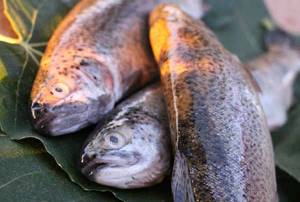
Lightly salted trout contains a large amount of useful vitamins and minerals, and therefore it is often recommended for people with melancholy or depression, since its regular inclusion in the diet helps cope with bad mood. It also helps remove harmful toxins from the body and helps fight intestinal diseases.
If we consider the benefits and harms of lightly salted trout, we cannot fail to mention phosphorus, which has a positive effect on the body, improving the functioning of the brain and circulatory system. However, it is worth mentioning the most important disadvantage of this product - it should not be eaten by hypertensive patients, since the salt contained in the dish can easily raise blood pressure, which will negatively affect well-being.
The benefits and harms of salted trout also cannot be underestimated. With the help of this product you can significantly influence the functioning of the most important systems in the human body. Omega-3 fatty acids help maintain normal cholesterol levels in the blood and also affect the condition of the circulatory and nervous systems. Surprisingly, in salted trout you can find 8 amino acids, which doctors consider necessary for a person to lead a normal life.
Among the harmful qualities, it is worth mentioning that such fish should not be consumed by people with diseases of the liver and gastrointestinal tract, since fats and salt can harm them.
Trout is a real boon for the body. This fish is distinguished by a rich list of substances important for human life and brings great benefits to the entire body. Very often, cardiologists and some others recommend including this delicacy in the diet of their patients.
1. The high content of omega-3 acids allows you to remove toxins and waste, helps improve a person’s emotional state, and has a positive effect on mood in stressful situations and severe mental stress.

2. Phosphorus contained in fish provides great support to the brain, improves mental activity by optimizing blood circulation, and serves as a preventive measure in the fight against Alzheimer's disease.
3. Eating salmon fish helps:
- • cleansing of blood vessels;
- • lowering cholesterol levels;
- • improving the functioning of the gastrointestinal tract;
- • slowing down the aging processes of cells and tissues of the body;
- • increase metabolism;
- • preventing serious heart disease.
4. Incredibly valuable trout meat for people with signs of anemia or suffering from this disease.
5. For men, red fish is also an incredible storehouse of nutrients. Consumption of this seafood allows you to quickly restore vitality and strength after hard work or intense physical activity. In addition to this, the selenium contained in trout helps improve sperm motility and increases the ability to reproduce in those who are struggling with infertility.
Description and types of trout
There are several varieties of salmon representatives:
- lake;
- rainbow;
- stream;
- loach;
- brown;
- Ohrid, which is found in Macedonia;
- Apache trout.
Each species has its own distinctive features and properties. Individuals from freshwater reservoirs reach 50 cm in length, seawater – 100 cm. Often trout are raised in the sea and then transferred to special farms. In stores, individuals are sold at the age of 2 years and weighing up to 2 kg.
It is difficult to confuse marine inhabitants with other types of fish. She has a truncated muzzle and a compressed body on almost all sides. The teeth are arranged in 2 rows. Males weigh less than females. They have more teeth and a larger head. The color of the carcass depends on the habitat. If the bottom is dark, then the fish will also be dark in color.
The trout has an olive-colored back, green or yellow sides, and a large white belly. After 2 years of existence, the fish is ready to spawn. This lasts one month in areas where there is no fast current.
Possible harm from eating trout
There are a number of caveats that need to be taken into account:
- People with gastrointestinal diseases and liver pathologies are not recommended to consume large quantities of marine inhabitants. Because it is necessary to follow a low fat diet.
- Pregnant women and during lactation should not overuse trout, as some varieties contain mercury, which affects the child’s body and can cause harm.
- You need to cook fish properly - raw meat can contain parasites.
Is trout ok for pregnant and nursing mothers?
The benefits of trout during pregnancy are invaluable - it is important for both the adult body and the baby. It is a source of protein, fatty acids, phosphorus, and iodine. Young mothers can eat white meat three times a week. It is recommended to eat red trout no more than 2 times a month, as it can provoke an allergic reaction. During breastfeeding, they eat the same varieties that they consumed while carrying the baby. Because this will reduce the risk of allergies.
Some types of fish contain mercury, so during pregnancy and breastfeeding, you should not abuse this product as it will cause harm. It is recommended to eat healthy trout with white meat every week. It has been noticed that later the baby will develop allergies extremely rarely.
Important! It is recommended to conduct a reaction test before use. You need to eat a small piece of the product and monitor the baby’s condition for several days; if everything is fine, you can safely consume it.
It is better to cook the product by steaming, in the oven or boiling in a pan.
Chemical composition
The meat of representatives of the salmon family is tender, oily, bright red or milky-cream in color with a fragrant intermuscular layer of fat. Trout lends itself to all types of heat treatment: frying, smoking, boiling, pickling, stewing, steaming, spit. It can be dried and served as a snack for alcoholic drinks. Delicacy meat is baked whole or stuffed with nuts and fruits. It is used to make aromatic, oily first courses (fish soup, soups). Sashimi, tartare, and Japanese sushi are prepared from raw fish.
100 grams of trout fillet contains:
- – 71.87 grams;
- – 19.20 grams;
- – 2.10 grams;
- ash – 1.31 grams;
- – 0 grams.
The ratio B: F: Y is 80%: 20%: 0%.
Table No. 1 “Chemical composition of trout fillet”
| Nutrient name | Nutrient content per 100 grams, milligrams |
| Vitamins | |
| 0,019 | |
| 0,123 | |
| 0,105 | |
| 5,384 | |
| 0,928 | |
| 0,406 | |
| 0,012 | |
| 0,00445 | |
| 2,4 | |
| 481 | |
| 271 | |
| 67 | |
| 39 | |
| 31 | |
| 1,08 | |
| 0,7 | |
| 0,158 | |
| 0,109 | |
| 0,0126 | |
The nutritional value of trout depends on the cooking method. 100 grams of boiled king fish contains 89 kilocalories, smoked - 132, canned - 162, lightly salted - 186, fried - 223.
What is fattier: salmon or trout?
Trout stands out from other fish, but it also has some similarities with them, which can confuse even an experienced fisherman and buyer.
From pink salmon
Pink salmon and trout belong to the salmon family. This is where the list of their similarities ends, since the fish differ both in appearance and in other factors. Thus, pink salmon live only two years and live only in the seas of the Pacific Ocean. Trout mainly lives in rivers, but it can also be found in the seas. Trout also live much longer.
As for appearance, pink salmon are distinguished by a convex curve on their back, but only males have it. Females have a more elongated body and a sharp head. Also, pink salmon is distinguished from trout by its color, which has an olive tint.
From chum salmon
Chum salmon can only be found in the Pacific seas, as it is exclusively a marine fish, while trout prefers fresh water.
Regarding the appearance, we can say the following:
- Due to the fact that trout prefer flowing rivers, its body has a more streamlined shape and a massive tail that helps overcome strong currents. The shape of chum salmon looks more refined, with many smooth curves, and its tail is less developed than that of trout.
- Trout meat is richer in fatty acids and also more elastic to the touch. Chum salmon meat is slightly inferior to trout in terms of chemical composition, but is almost the same in taste. The price of chum salmon is slightly lower than that of trout, so the former is in great demand among buyers.
- The color of chum salmon is often silvery-white, with rare olive-colored specimens, while trout can be brown, greenish, gray and yellowish in color.
From coho salmon
Coho salmon differs from trout in its impressive size, growing up to one and a half meters in length and having a body weight of 15 kilograms. Also, the gray back of coho salmon lacks the dark spots that can be found on trout.
Coho salmon meat has a rich scarlet color, and trout meat looks pale against its background. They are similar in texture and flavor, but when cooked, coho salmon remains a little tough, while trout becomes softer.
From brown trout
Brown trout is another member of the salmon family. It is often called anadromous trout due to the great external similarity of these fish. Brown trout prefers to live in lakes, unlike trout, which prefers flowing mountain rivers.
The meat of brown trout and trout is almost identical in appearance and smell, but trout has a more impressive range of beneficial microelements and fatty acids, as it lives in better conditions.
From salmon
Trout and salmon are very similar in appearance, as they are representatives of the same family. It is quite difficult to distinguish them, since there are not only external but also internal similarities. The meat of these fish is almost identical in color, smell and consistency. However, salmon meat is considered fattier.
From sockeye salmon
Sockeye salmon cannot be confused with trout, since the fish has bright red scales, a clearly visible hump on the back and a slightly curved mouth, rounded inward and reminiscent of a bird's beak.
"Royal" recipes
Ingredients:
- onion – 1 head;
- - 1 piece;
- broccoli;
- trout fillet – 600 grams;
- white wine – 200 milliliters;
- lemon – 0.5 pieces;
- fresh tomatoes – 3 pieces;
- salt;
- a set of spices (rosemary, savory, oregano, mustard seeds, allspice, cardamom, paprika, fennel).
Cooking principle:
- Cut the fish meat into portions.
- Mix salt and spices. Generously provide the trout with the fragrant mixture and cover with lemon rings.
To ensure that the fish is saturated with spices and acquires a pleasant aroma, leave it in the marinade for 30 minutes.
- Prepare the vegetables. Peel them, cut the carrots into strips, onions into rings, tomatoes into slices.
- Preheat the oven.
- Line a baking sheet with foil (15 x 15 centimeter squares). Place a vegetable bed in portions, on top of which place pieces of trout and a slice of lemon.
- Pinch the edges of the foil so that the juice does not leak out, and the fish will be baked in its own marinade.
To enhance the taste and add piquancy to the dish, pour 50 milliliters of wine into the resulting “pockets”.
- Place the pan with the fish in the preheated oven for 30 minutes.
Fish pie
Ingredients:
- trout fillet – 2 kilograms;
- dough – 1 kilogram;
- butter – 50 grams;
- onions – 2 heads;
- parsley – 1 bunch;
- Bay leaf;
- allspice peas;
- salt.
Cooking sequence:
- Divide the dough into 3 parts. Connect the first two and roll out an oval 1 centimeter thick. Make a small circle from the third part.
- Wash and cut the trout into pieces. Salt and pepper it.
- Chop the greens and mix with the fish.
- Peel the onion and cut into rings.
- Place the dough in a baking dish, spread the fish and herbs on top of it, then the onion rings. Raise the edges of the oval with a “side”.
- Grate the butter and place it on the filling.
- “Close” the pie with a small oval, pinch the ends of the dough with the sides.
- Use a fork to make holes in the center to allow steam to escape.
- Preheat the oven to 180 degrees.
- Place the pie pan in the oven for 60 minutes.
Before serving, cut the hot fishmonger into portions.
What does caloric content depend on?
This fish of the salmon family is a low-calorie product. On average, 100 grams of pure fresh trout meat contains from 85 to 95 calories, depending on the environment and habitat of the fish and the season it was caught. The lightly salted delicacy contains up to 200 calories, and the baked version contains approximately 125-140 calories per hundred grams.
Red fish has high nutritional value due to its chemical composition, rich in vitamins and other useful elements.
It contains a complex of valuable substances:
- Omega-3;
- calcium;
- aliphatic amino acids;
- zinc;
- phosphorus;
- potassium;
- iodine;
- vitamin A;
- vitamin D;
- B vitamins;
- tocopherol;
- niacin;
- cholesterol;
- iron;
- sodium;
- potassium;
- iron;
- magnesium;
- fluorine;
- copper;
- sulfur;
- manganese;
- selenium;
- nickel.
The calorie content of the product is approximately 90 kcal per 100 grams.
The energy value is determined by the variety of varieties and processing methods. The calorie content in its raw form with a low fat content is 88 kcal based on 100 g of product. The nutritional value of fatty varieties reaches 231 kcal/100 g.
The calorie content of boiled trout is about 107 kcal/100 g. The number of calories in baked fish is approximately 184 kcal/100 g, since during cooking the liquid contained in the trout meat evaporates and the dry mass of the dish increases.
The energy value of salted and dried fish ranges from 185 kcal/100 g to 250 kcal/100 g, depending on the amount of vegetable oil added.
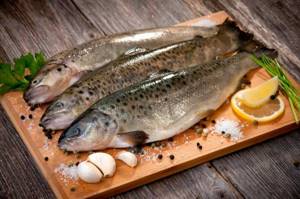
The calorie content in salmon caviar is 245 kcal per 100 grams of product taken.
Where are trout found, photo
[adsp-pro-2]
To know where trout live, you can often simply know their species. The very name of some individual specimens can indicate where the fish was caught from.
Types of trout:
- — river trout, photo below:
- - Sevan and white;
- — Karelian and lake trout (Karelian trout lives in the waters of the Karelian Territory, lake trout is mostly found in lakes of the USA (Great Lakes), as well as in Canada and Alaska).
- - brook trout and others.
What kind of Sevan trout is, the photo below demonstrates in full.
In the Pacific Ocean you can find quite a lot of varieties of this fish, including golden trout, Arizona, Caucasian, mykiss, Biwa and others.
Sea trout or river fish are found, as a rule, within the Western European continent, but they can also be found in our country in the northwestern part. Karelian trout is also the heritage of Russia. You can catch this type of salmon fish in the reservoirs of Karelia.
Pros of trout
Red fish meat is a valuable source of vitamins, minerals and.
- depression;
- osteoporosis;
- oncology;
- psoriasis;
- allergies;
- diabetes mellitus;
- heart diseases.
Boiled fish has low calorie content, so it is included in the menu for weight loss.
Why eat trout?
The substances that make up red fish have a complex effect on the human body:
- They take out the extra one.
- Regulate blood levels, gastric juice secretion, and water metabolism.
- Improve blood circulation and keep the heart healthy.
- Participate in the breakdown of fats, amino acid metabolism, hormone synthesis, and energy metabolism.
- Reduce the risk of developing myocardial infarction (primary or recurrent).
- Activate mental activity.
- Strengthens the immune system, nervous and cardiovascular systems.
- Slow down the aging of the body.
- Prevents the formation of tumors of the malignant spectrum (fights free radicals).
- Improves the absorption of iron and the condition of the skin and hair.
- Increases the strength of tooth enamel.
- They break down and remove carcinogens.
- They fight stress, relieve fatigue, and have a tonic effect.
- Support reproductive function.
- Reduce blood pressure.
Thus, trout meat has a healing effect on the human body. Nutritionists recommend eating fish 3–4 times a week, 200–300 grams per day.
Habitats
Trout lives in the sea, rivers, lakes, and large streams. It is most widespread in the USA and Norway, countries where sport trout fishing is very popular. In Europe, it can be found in mountain or forest rivers (streams), with fast flows, the water of which is rich in oxygen.
There are a lot of trout in lakes such as Onega and Ladoga. The high-altitude Lake Sevan, in Armenia, is in a special place - there is a species of trout there that cannot be found anywhere else, so it is unique. The deep-water reservoirs of the Kola Peninsula are rich in trout. There are many trout in the Baltic countries, where they live in rivers flowing into the Baltic Sea.
Habitats may change or expand. This, for example, happened with rainbow trout, which initially could only be found in North America, but is now widespread throughout almost all of Europe, as it was introduced and propagated artificially.
How to choose the right trout
To get a tasty dish, you need to choose a good source of seafood. Some tips:
- You need to pay attention to the appearance of the product. Good, fresh seafood has a slippery, elastic skin. When you press on it with your finger, it quickly returns to its original shape.
- Pay attention to the eyes - they should not be cloudy; if they are, the fish is not fresh.
- If the gills of the fish are dark brown, this indicates that the seafood is stale and harmful. High-quality seafood has pinkish, fresh gills.
- If the color of the carcass is unnatural and bright, then it is better not to buy it.
- A large belly indicates that the fish contains milk or caviar.
How to pickle trout at home
Ingredients:
- fish fillet – 500 gr.;
- lemon - half;
- salt;
- ground black pepper.
Step-by-step preparation:
- The fish fillet is cut into pieces, the lemon is cut into thin slices.
- The meat is salted, peppered on all sides, and transferred to a bowl.
- Transfer to the refrigerator overnight.
- The next morning the fish is ready to eat. It can be used for appetizers, salads, pies, canapés.
The benefits of lightly salted trout are no less than those of boiled trout. It contains a significant amount of thiamine and riboflavin.
The nutritional value
The rich taste is provided by the strong muscles of the fish, which are full of vitamins, omega-3s and acids. Trout is also rich in beneficial microelements.
100 grams of trout contains:
- 10 mcg vitamin A;
- 5 mcg vitamin B12;
- 33 mcg vitamin D;
- 59 mg cholesterol;
- 2.7 mg vitamin E, etc.
As for proteins and fats, there are 17.5 g of them per hundred grams of trout.
The product is attractive not only for its taste, this fish is also incredibly nutritious. It contains a huge amount of Omega-3 fatty acids, as well as vitamins of almost all groups (B, A, E, PP, D, etc.), amino acids, micro and macroelements necessary for our body. The most significant ones that I would like to note are iodine, phosphorus, magnesium, sodium, glutamic acid, etc.
When can trout be given to a child?
The benefits and harms of trout for a child’s body have been well studied. Trout is rich in vitamins and microelements and fits perfectly into the diet of a growing organism. It is not recommended to give trout to children under three years of age, as there is a risk of allergies.
Ready trout is usually served with side dishes. It is important to choose the right dish that will be combined with fish. It is especially important to take into account the method of its preparation, because you cannot serve a fatty side dish with baked fatty fish, as this is fraught with negative consequences for the stomach.
In general, it is better to use the following products as a side dish for trout:
- potato;
- cabbage;
- tomatoes;
- rice and other cereals;
- celery;
- green pea;
- carrot;
- green beans;
- beets;
- Bell pepper;
- fresh herbs;
- eggplants and zucchini.
For trout steak fried on the grill or in a frying pan, it is better to prepare rice, pasta, stewed or boiled potatoes, and vegetable salad dressed with olive oil.
Steamed trout is best served with side dishes of baked or stewed vegetables, pasta with cheese or cream sauce, fried potatoes and salads dressed with sour cream or mayonnaise.
For trout baked in the oven, it would be correct to serve baked potatoes, eggplants, and a fresh vegetable salad seasoned with vegetable oil.
